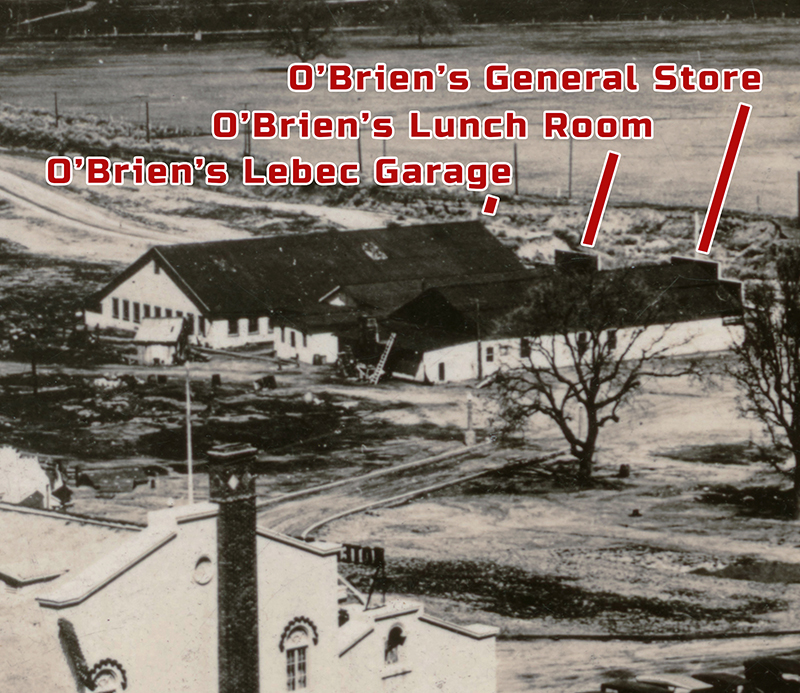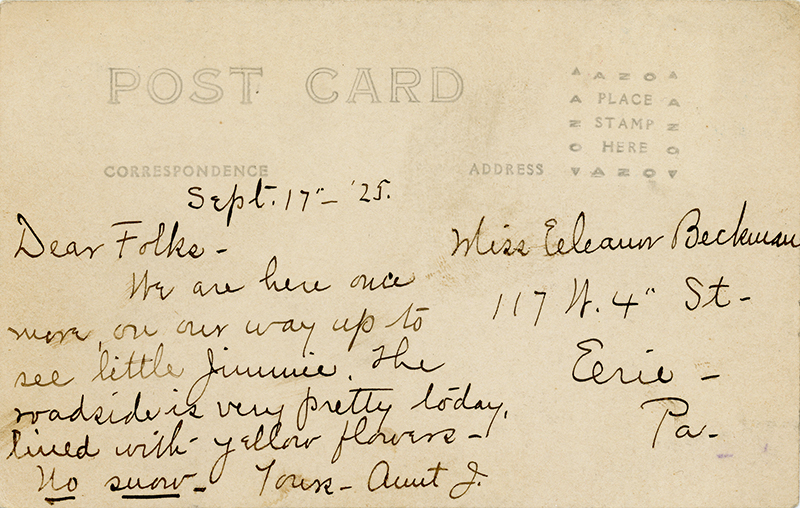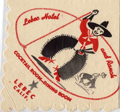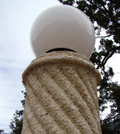|
|

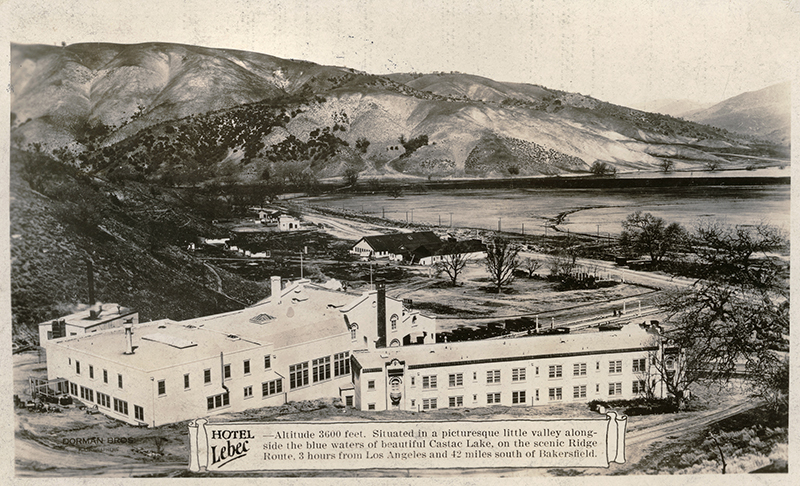
Click image to enlarge
Hilltop view of Hotel Lebec, real-photo postcard, 1921-1923, by Dorman Bros. of Bakersfield. Same series as this view. The postcard is addressed to Miss Eleanor Beckman of Erie, Penn. Glue residue shows a postage stamp was affixed to it at one time, but it was not canceled. A handwritten message on the back is dated September 17, 1925, but the image itself is a bit older — no earlier than 1921, when the hotel opened, and no later than 1923, when most of the other buildings in this photograph burned down. Sender's message (see below) reads:
Sept. 17th, '25.
Dear Folks— We are here once more, on our way up to see little Jimmie. The roadside is very pretty today, lined with yellow flowers. No snow. Yours, Aunt J. The book, "Lost Hotels on California's Ridge Route" (Harrison Scott 2007), includes a copy of this RPPC, along with a substantially similiar view that is probably a different strike of the same photograph. Scott identifies the other print as 1922. Visible in the middle of the photo are the wood-frame general store, lunch room and auto garage that Thomas O'Brien, a saloon keeper from Bakersfield, built in 1915 when the Ridge Route Highway came through. He also built 25 cabins (ibid.:6-9). Collectively, these comprised the original Lebec Hotel. Photographic evidence shows the cabins were still present while the lavish new Hotel Lebec was under construction in 1919-1921, but most of them had been removed by the time the hotel opened May 21, 1921. Only a handful remained; they are visible here, to the viewer's left of the commercial buildings. We don't know what is under construction to the viewer's right of the commercial buildings. O'Brien had sold the new hotel and adjacent buildings to Foster Curry, son of the concessionaire at Yosemite, by November 1923, when all of the wood-frame commercial buildings and most of the cabins burned down. "Curry had not attended to cleaning the grease from the restaurant's flue on a regular basis," Scott writes (ibid.:9). Taking the place of the wooden commerical buildings was a new rock structure housing a coffee shop, bar, grocery store, post office, Richfield gas station and an extensive garage (ibid.). Visible at far right, just above the centerline, is the tree-lined edge of Castac Lake, aka Castaic Lake. Castaic Lake is a natural water body in Lebec, not to be confused with the manmade Castaic Lake Reservoir that came decades after this photograph was printed. Front of RPPC reads:
Altitude 3600 feet. Situated in a picturesque little valley alongside the blue waters of beautiful Castac Lake, on the scenic Ridge Route, 3 hours
from Los Angeles and 42 miles south of Bakersfield.
As of 2012, Kern County has approved, and a federal court has upheld, a 3,450-home development project to surround the "real" Castaic Lake at Lebec.
About Dorman Bros. According to Henley's Photo of Bakersfield (accessed 2018), Charles F. Dorman, a photographer from The Denver Post, and his younger brother, Claude, began working at a haberdashery in Bakersfield in 1904. In 1907 they went into business with John B. James and formed James & Dorman, a portrait studio at 1677 Chester Avenue. The partnership dissolved in 1911. The name changed to Dorman Bros., same address, while James opened a studio elsewhere in Bakersfield. The brothers split up in 1928. Claude, the younger brother, stayed at 1677 Chester Avenue but changed the business name to Dorman's Photo Shop. Charles opened his own studio at 1724 Truxton Avenue. Charles died in 1935. Claude sold Dorman's in 1945. It changed hands again in 1946, 1947 and finally in 1948 when it was purchased by Joe and Ann Henley. Claude Dorman died in 1950. In 1954, Joe Henley formally changed the name from Dorman's Photo Shop to Henley's Photo Shop. Henley's opened a second shop in 1962 and moved in 1977 from its original location on Chester Avenue, where the Dorman brothers started out, to the company's present (2018) location at 2000 H Street in Bakersfield where it is owned and operated by the former Henley's sales manager, Jimmy Bunting and family.
About Hotel Lebec.
About the Lebec Hotel. Harrison Scott in Californian Historian (Vol. 43 No. 4, Summer 1997) writes: The last major structure in place during the highway's glory was the Lebec Hotel. Construction began Jan. 15, 1921, and it opened for business four months later, on May 21. The hotel was the brainchild of entrepreneur Thomas O'Brien, a saloon-keeper from Bakersfield. Financing for the opulent hotel was provided by Cliff Durant, an automobile manufacturer. The Lebec hotel was a "complete gambling joint with a ball-room, rooms and apartments" during its heydays from 1925 to 1934. Clark Gable and his actress wife, Carole Lombard, as well as gangster Benny "Bugsy" Siegal, frequented the Lebec Hote1. A 1926 touring guide describes it: "Hotel Lebec is new and high class, 80 rooms, thoroughly modern single $2-$3, with bath $4, coffee shop open 24 hours."The Lebec Garage nearby was the largest and best equipped on the ridge. Labor was $1.75 an hour, increasing to $2.40 after 6 p.m. Shortly after the hotel opened, Durant sold his interest to Foster Curry (son of the concessionaire at Yosemite) of San Francisco. Early postcards from this period show the hotel under its brief stint as "Curry's Lebec Lodge," once located along the west side of Lebec Road just north of the Lebec off-ramp. The hotel fell into disrepair and was officially closed on November 13, 1968, in response to health department charges concerning its substandard water system and dilapidated condition. The hotel went into receivership and was purchased by the Tejon Ranch Company. They torched the hotel and demolished the remains on April 27, 1971, only two weeks after acquiring the property. Two tall Italian Cypress trees mark the former location. Read more here.
LW3255: 9600 dpi jpeg from original photograph purchased 2018 by Leon Worden.
|
Pollack Story
First Lebec Hotel 1910s
Hotel Durant 1921
Durant's Dining Room 1922
Curry's Room Key & Fob, 1922/25
Curry's Lebec Lodge, Early 1920s x4
Postcard 1920s
Postcard 1921-1923
Postcard 1921-1923
1920s
Curry's March 1924
At Sunset ~1920s
3 Views ca. 1926
1-18-1927
1927
Coffee Shop, Late 1920s
Tourist 7/30/1929
Postcard 1920s/30s
Postcard 1920s/30s
Postcard 1920s-30s
Lindbergh 1930
Late 1930s
Postcard 1940s
Matchbook 1940s
Coffee Shop, Santa Fe Buses 1940s
Coffee Shop 1940s
Napkin 1940s
Coffee Shop Menu 1949
Postcard September 1952
Snow Day 1/6/1955
July 1957
Menu ~1960s
Hotel Burns 1971
Lamp Posts 2012 x4
Hotel Site 2013
|
The site owner makes no assertions as to ownership of any original copyrights to digitized images. However, these images are intended for Personal or Research use only. Any other kind of use, including but not limited to commercial or scholarly publication in any medium or format, public exhibition, or use online or in a web site, may be subject to additional restrictions including but not limited to the copyrights held by parties other than the site owner. USERS ARE SOLELY RESPONSIBLE for determining the existence of such rights and for obtaining any permissions and/or paying associated fees necessary for the proposed use.
